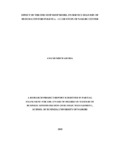| dc.description.abstract | Kenya has had challenges with public service delivery including slow turnaround timelines in service delivery, substandard service quality, challenges with staff attitude in government institutions, and corruption cases in government services. To counter these challenges in service delivery, the government of Kenya introduced diverse initiatives including Results Based Management framework that was founded performance contracting and citizen service charters. The limited success of these initiatives led the government to conceptualize the One Stop Shop Model in service delivery in order to address these challenges. The One Stop Shop Model has been found to have diverse influence on public delivery aspects including improvement in access to government services, decentralization of government service points, and increase in awareness in the range of government services. This study therefore sought to establish the influence of the One Stop Shop Model on service delivery of Nakuru Huduma Center. The theoretical review of this study was undertaken through the use of the Expectancy Disconfirmation Theory (EDT), and Cognitive Dissonance Theory. This study adopted a descriptive research design since it allowed the variables to be studied in their natural form without the researcher manipulating them in any way. The target population consisted of 545 members who comprised of 400 customers and 35 staff. The study used a sample size of 81respondents. Data was collected using structured questionnaires. The SPSS software version 22 was used to generate both descriptive and inferential statistics. The descriptive statistics included frequencies, means, and standard deviations. A multiple liner regression was used for the inferential statistics. The study established that queue management (r=0.766), ease of application of government services (r=0.698), integrated service provision (r=0.810) and issuance of government documents (r=0.773) were related to public service delivery. It was further established that 67.6% (R2=0.676) of the variation in the level of public service delivery in Huduma Centers was due to the changes in the level of queue management, ease of application of government services, integrated service provision and issuance of government documents cumulatively. The study further recommends policy makers at Huduma Centers to first prioritize policies that are geared towards easing the application for government services, followed by policies that seek to improve the issuance of government documents, then policies on integrated service provision and lastly policies in queue management. This study is of value to the management of Huduma Center and other service centers around the country in terms of decision making. The study highlighted the efficiency of diverse aspects of one stop service models and their role in enhancing service delivery. This enables the management of these centers to make policy decisions that further enhance the efficiency of the One Stop Shop Model. The study results will improve on the diverse practices that are undertaken within Huduma Centers | en_US |



